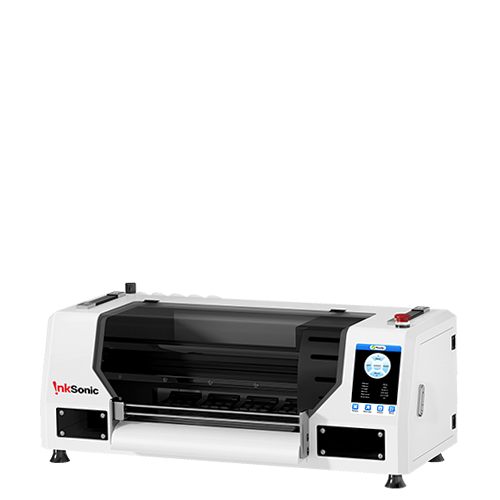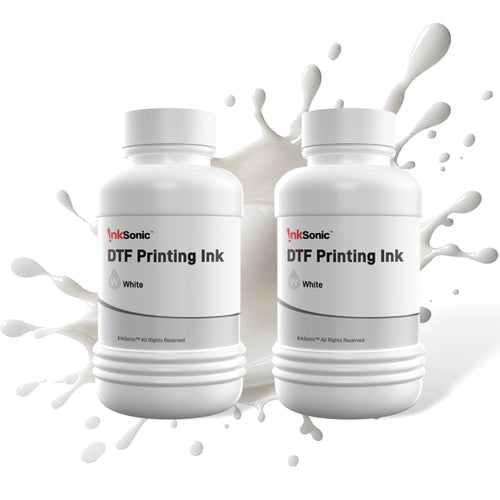Are DTF and UV DTF The Same?
Actually, they are completely different. DTF printers and UV DTF printers use different technologies and inks, and are suitable for different material surfaces. The only thing they have in common is that both require the “transfer” step.
If you are new to this business, this piece will provide you with a quick perspective of the difference between these two approaches and help you choose the most appropriate for you.
What Are the Main Differences Between DTF and UV DTF Printers?
1. Materials & Tools Required
Item |
DTF |
UV DTF |
Ink |
Hot transfer ink |
UV curing ink |
Transfer Film |
DTF-specific PET film |
UV DTF specific A film + B film |
Hot Melt Powder |
Required |
Not required |
Dryer |
Required |
Not required |
Heat Press |
Required |
Not required |

Simple Understanding:
DTF is more like traditional T-shirt printing, requiring powder and heat pressing; UV Direct-to-Film cures into a sticker, similar to sticker printing.
2. Production Process Comparison
-
DTF Printing Process:
Image Design → Print White Ink + Color Ink → Sprinkle Powder → Dry → Heat Press Transfer onto Fabric

-
UV Direct-to-Film Printing Process:
Image Design → Print UV Ink → UV Light Curing (inside machine) → Film Transfer onto Hard Surfaces

DTF is more suitable for fabric products, while UV Direct-to-Film is suitable for hard objects like cups, phone cases, acrylic, wood, metal, etc.
3. Transfer Method Comparison
DTF transfer and UV Direct-to-Film transfer have obvious differences in transfer methods.
- DTF Transfer: Uses heat press method, requiring a heat press machine to transfer the image onto the fabric surface. The whole process includes: sprinkling powder, baking, pressing, and peeling the film.

- UV DTF Transfer: Uses cold application method, not requiring high temperature or heat press machine. Simply peel off the A film with the printed image, stick it onto the surface, press gently, and peel off the B film to complete the transfer.

Tips: In UV Direct-to-Film printing, the A film is the "canvas" for the printed image, while the B film is the "transfer tool" for applying the image onto the object.
4. Different Applicable Ranges
-
DTF Printing Suitable for:
T-shirts, sweatshirts, canvas bags, fabric bags, hats, cotton, polyester, and other flexible materials.

-
UV Direct-to-Film Suitable for:
Glass, metal, cups, notebooks, acrylic, leather, wood, phone cases, and other hard or heat-sensitive surfaces.

How to Choose?
Based on Target Customers/Product Types:
- If you plan to do clothing or fabric printing, choose DTF printers.
- If you plan to do mugs, phone cases, or small gift stickers, choose UV DTF printers.
Based on Budget and Hands-on Ability:
- Want a simpler entry with fewer operations? UV DTF is more suitable for you.
- Want lower costs and a wider application range? DTF might be better for you.
Comparison
Item |
DTF |
UV DTF |
Ink |
Hot transfer ink |
UV curing ink |
Materials |
PET film + hot melt powder |
A film + B film |
Requires Heat Press |
Yes |
No |
Applicable Materials |
Fabric |
Various hard surfaces |
Initial Cost |
Lower |
Relatively higher |
Operating Process |
Print → Sprinkle Powder → Dry → Heat Press |
Print → UV Cure → Cold Application |
Print Effect |
Vibrant colors, soft |
Saturated colors, strong 3D effect |
Suitable Audience |
Fabric printing users, T-shirt shop owners |
Gift customization, sticker entrepreneurship, small item customization |
For beginners in custom clothing, DTF is a great entry point—technology is mature, materials are widely available, and there are plenty of tutorials.
→ Recommended: XP600 U13

For gift and sticker businesses, UV Direct-to-Film is more suitable for beginners—no heat press required, simpler workflow, and less manual labor.
→ Recommended: VF13

Let these guides and user-friendly machines help you start your creative journey.
Summary
Although DTF and UV DTF have similar names, they are actually two completely different printing systems. DTF fits best for printing on fabrics, whereas UV DTF works as sticker printing, which can be used for different hard materials. As a beginner, choose the best among the two according to your product type, price, and working capability.



































